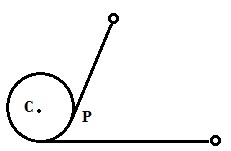For a particle attached to a rope moving along a circle that has the length of rope as radius, the tension provides centripetal force and work done by tension is zero since velocity of particle is perpendicular to tension at any instant.
But I am thinking about this case:

Here, a particle is tied to a vertical cylinder and is given a velocity perpendicular to rope. My doubt is the work done by tension. The length of rope decreases and the particle moves towards P which is along the direction of tension. So the work done is non zero. Am I correct? (Let the particle move in a frictionless surface)
